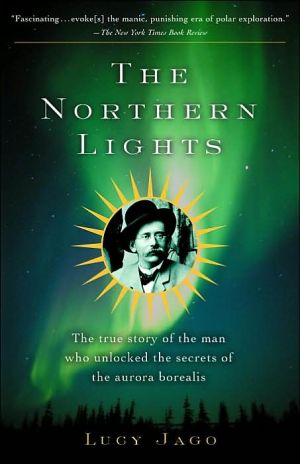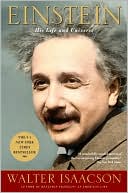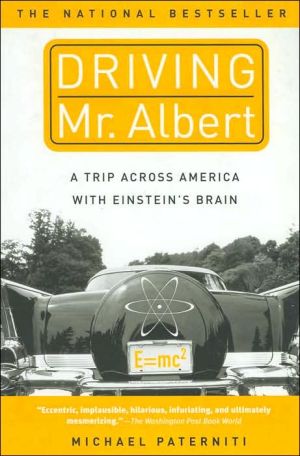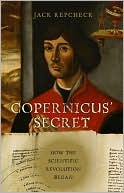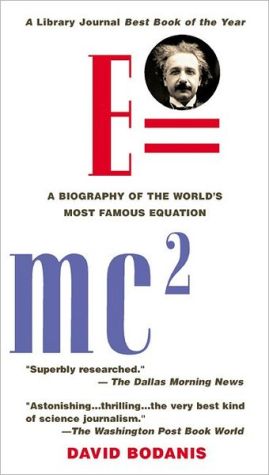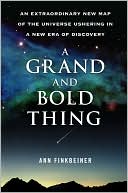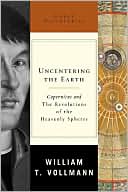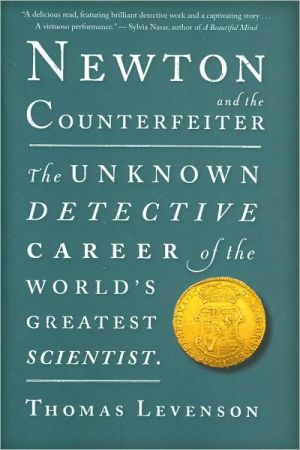The Northern Lights
Science, biography, and arctic exploration coverage in this extraordinary true story of the life and work of Norwegian scientist Kristian Birkeland, the troubled genius who solved the mysteries of one of nature’s most spectacular displays. \ Captivated by the otherworldly lights of the aurora borealis, Birkeland embarked on a lifelong quest to discover their cause. His pursuit took him to some of the most forbidding landscapes on earth, from the...
Search in google:
Science, biography, and arctic exploration coverage in this extraordinary true story of the life and work of Norwegian scientist Kristian Birkeland, the troubled genius who solved the mysteries of one of nature’s most spectacular displays. Captivated by the otherworldly lights of the aurora borealis, Birkeland embarked on a lifelong quest to discover their cause. His pursuit took him to some of the most forbidding landscapes on earth, from the remote snowcapped mountains of Norway to the war-torn deserts of Africa. In the face of rebuke by the scientific establishment, sabotage by a jealous rival, and his own battles with depression and paranoia, Birkeland remained steadfast. Although ultimately vindicated, his theories were unheralded—and his hopes for the Nobel Prize scuttled—at the time of his suspicious death in 1917. The Northern Lights offers a brilliant account of the physics behind the aurora borealis and a rare look inside the mind of one of history's most visionary scientists. Publishers Weekly Crackling with Arctic adventure, this biography of the brilliant Norwegian physicist Kristian Birkeland (1873-1917) is set in the early 20th century and cast against the driving spirits of the Edwardian Age. Freewheeling capitalism, imperialism, industrialization and a near reverence for the growing myth of science informed Birkeland's cerebral and adventurous life. A stolid Scandinavian with a wide-ranging imagination, he undertook the first scientific studies of the aurora borealis, which had previously been explained by a range of theories that included the supernatural. Detailed descriptions of his expeditions to the far polar reaches of the earth are filled with scientific wonder and life-threatening hazards. Through his short life, Birkeland continued his studies of the northern lights. He evolved a theory, proven after his death, that the origin of this natural phenomenon is in the electromagnetic energy of the sun and its profound influence on the earth. At the same time, he also developed a financially successful method of extracting nitrogen, for fertilizer, from the air and performed seminal work on the military applications of electricity. Birkeland also traveled to romantic places for research: Russia, Egypt, Sudan and Japan. Yet beneath the apparently successful surface of Birkeland's life were deep strains. He abused alcohol and barbiturates, lost friends and colleagues, destroyed his marriage and died alone and paranoid in a foreign country, yielding a bittersweet story capably told by British TV journalist and BBC producer Jago. Illus. (Oct. 1) Copyright 2001 Cahners Business Information.
from Chapter 1\ Odin's Messengers\ 14 October 1899\ Finnmark, Northern Norway, within the Arctic Circle\ It is true of the northern lights, as of many other things of which we have no sure knowledge, that thoughtful men will form opinions and conjectures about it and will make such guesses as seem reasonable. But these northern lights have this peculiar nature, that the darker the night is, the brighter they seem, and they always appear at night but never by day, and rarely by moonlight. They resemble a vast flame of fire viewed from a great distance. It also looks as if sharp points were shot from this flame up into the sky, they are of uneven height and in constant motion, now one, now another darting highest; and the light appears to blaze like a living flame . . .\ —-kongespeilet (The King's Mirror), c. 1220-30, Norse epic\ It was ten in the morning and -25° Celsius when the group left the small mining town of Kaafjord for the summit of Haldde Mountain, Haldde being a Lappish word for "guardian spirit." The cold should have scattered the clouds but halfway to the top the wind engulfed the men in blinding eddies of snow and ice. Their guide, Clement Isaakson Hætta, was a Lapp who had abandoned the traditional activity of herding reindeer to become the local postman serving the few Norwegians, Swedes, and immigrant workers from Finland, the Kvens, living in this northerly outpost. Short, with bandy legs, he bent his body at the hips into a right angle and pushed on through the storm like a swaying battering ram. Firmly wrapped around his wrist were the leather reins of the leading reindeer that was struggling to pull a sled piled high with a bizarre cargo of instrument boxes, trunks, and tripods. Seven reindeer, similarly yoked, were lashed behind the leader, and roped to them were five huddled figures.\ Directly behind Hætta was the instigator of the expedition, Kristian Olaf Birkeland. He yelled to the guide above the screeching wind wanting to know whether it was safe to continue. He could not hear the response, as the storm scrambled Hætta's words and Birkeland was partly deaf from conducting noisy radio-wave experiments as a student. Festooned with reindeer skins, he appeared shorter than his five feet five inches. Only thirty-one years old, he was already balding across the dome of his fine-boned scalp. The snow stuck to his round spectacles but he had long given up scraping ice off the lenses and instead squinted between the rims and his fur hood. This unlikely adventurer had been made a professor of Norway's only university one year previously. He was the youngest of his colleagues in the Faculty of Science and Mathematics, his prophetic genius as a scientist emerging in his twenties when he solved problems that had defeated some of the brightest minds in Europe. Despite his youth, Birkeland was not a fit man; he loathed physical hardship and was more accustomed to long hours in the laboratory, hunched over diagrams and experiments. It was a comment on his devotion to scientific discovery that he was stranded on a mountain in eighty-kilometer-an-hour winds that howled continuously.\ The storm was worsening; the men had been walking for six hours and had covered a distance that would take only two in good conditions. The guide shuffled onward, chewing on black tobacco, damp wads of which he spat into the wind. To reach the summit of the mountain, and the hut that would provide them with shelter, it was necessary to leave the narrow plateau they were traversing and climb the exposed mountainside. The peak they were heading toward was engulfed in a mass of swirling snow and ice as dense as black smoke.\ Roped behind a breathless Birkeland came Bjorn Helland-Hansen, a gifted student in the medical department of Christiania University who was training to be a surgeon. Talented in science as well as medicine, he had attended Birkeland's lecture course and been inspired to join him on this adventure. He had just celebrated his twenty-second birthday. Tied to him was Elisar Boye, a Latin scholar who had been the first to volunteer for the expedition, presenting himself just a few hours after Birkeland posted a notice on the boards in the main hall of the university, requesting strong and able science students for a unique expedition to the Arctic Circle. At first Birkeland had thought that a Latin graduate would be of little use to him on a scientific mission, but Boye explained that he had achieved the best mark possible in mathematics, and eventually Birkeland relented in the face of the young man's enthusiasm. Boye looked much younger than his twenty-two years, with a smooth, pale complexion and clear blue eyes, on this day hidden inside his reindeer hood. He had stopped trying to see where he was going through the lashing snow and simply followed the direction of the tugging rope. Behind Boye came Kristoffer Knudsen, a twenty-three-year-old telegraphic engineer who had been working for the Norwegian railway until Birkeland lured him away with promises of adventure and pioneering science. He did not know the other members of the group and was the quietest when they began the ascent. As the storm intensified, he retreated ever further into his jacket and squinted at the ground immediately before his feet through the hairs of his hood. The tallest in the party, Sem Sæland, brought up the rear. Just turned twenty-five, Sæland had studied mathematics, astronomy, physics, and chemistry at the university, then traveled to Iceland, where he spent a year teaching before returning to Christiania University for further studies. There he met Birkeland, and was so interested in the professor's ideas that he had volunteered to join him on his expedition. Sæland repeatedly checked the knot in the rope linking him to the others as the driving snow was so thick he could see no more than a few centimeters beyond his nose.\ By four o'clock the light was fading. Hætta decided that they should turn round and head back down the mountain, but then immediately changed his mind, suggesting they continue to the hut as it could not be more than two kilometers away and it would be more difficult to go down than up. He cajoled and harried the reindeer, which would not face the wind and nervously shook their heads at the sharp points of ice pricking their eyes and noses. It was impossible to sit in the sleds as they lay so close to the ground that the men were pelted with ice and small stones. Soon some of the reindeer lay down flat and refused to move. Hætta, a large part of his face white with frostbite, followed their lead and threw himself onto his sled, declaring he could go no further and could not find the way forward. He told Birkeland to continue without him, keeping the wind in his face, but the professor knew that abandoning their guide would be a fatal mistake and told the group to make camp as best they could. Hætta crawled under his sled while the others dragged the remaining sleds and baggage to form a barricade, behind which they erected a low tent. They struggled into their reindeer sleeping bags with all possible haste while Helland-Hansen weighed down the guy ropes with boxes and trunks. By the time he entered the tent less than five minutes later, the tips of his fingers had turned white with frostbite.\ For twenty hours the five men lay in the cramped tent. They rubbed Helland-Hansen's fingers every quarter of an hour in an attempt to bring them back to life, and almost as regularly one of the five men had to push snow from the roof of the tent to prevent the suffocation of all those inside. Wherever there was a little shelter the snow heaped into thick, compact drifts that would trap them in a freezing vise if allowed to settle. They had nothing to drink or warm themselves with, having been assured by Hætta that the ascent was a matter of six hours' gentle climbing with a short, steep section at the summit. Birkeland had half a loaf of bread in his jacket that he tossed to Hansen in the darkness, hoping some food might distract him from the pain in his hands, but the noise of the wind was so great that he did not hear Birkeland yelling to him to eat the bread, and it froze to the consistency of rock within a few minutes. Gradually the little light that glowed through the snow-filled air was extinguished by the black night that fell by five o'clock. Inside the tent Birkeland was painfully aware that only a thin strip of canvas trembled between them and the lethal storm outside; one fierce gust and it could be ripped off. Without the tent they would be unlikely to survive.\ The men lay shivering in their sleeping bags, dozing fitfully through the night but being frequently awoken by particularly violent blasts of wind and ice or by hunger and thirst. They had put a bucket of snow inside the tent in the hope that it would melt with their body heat and they would have water to drink, but it remained frozen. Birkeland felt responsible for the safety of his talented charges who had followed him on this hazardous expedition. Aware that this area sometimes experienced week-long tempests of unbroken ferocity, he worried throughout the night about how they could survive if the storm continued the next day. Lying awake listening to the air howling through the mountain pass and over their tent, he waited for the slightest sign that the gale-force winds were easing.\ At ten the following morning Birkeland untied one of the leather strings holding down the tent flap but could see no more than a meter ahead. Not until midday did the wind abate sufficiently to risk venturing out. Birkeland banged on Hætta's sled to make sure the postman was still alive. Hætta shouted in reply that he was too cold to move but Birkeland insisted that they take advantage of the lull. Camp was struck, the sleds reloaded, and a reluctant Hætta once again led the group onward. They had only a few hours of daylight left to make the ascent, and without food and water it was imperative they find the shelter.\ As the six men trudged on, the snow finally stopped and only tiny ice crystals spun in the eddies of wind left behind by the fierce zephyrs now en route to central Finnmark, Kautokeino, and the Lapp reindeer camps of the plains. The clouds dispersed as quickly as they had arrived, and in the gathering twilight the Pole Star appeared, reassuring and constant. Without the cloud cover the cold intensified rapidly, and moisture frosted on their lips, while their breath trailed behind them in crystal plumes. The drifting snow made walking in boots impossible, so the men strapped small skis to their feet. The undersurface of the skis was covered in reindeer skin in such a way that gliding forward was easy but the hairs sticking in the snow prevented them from slipping backwards. Nearly two hours later they reached a gently sloping plateau at the foot of the summit. Hætta pointed to the top of the peak. In the deepening twilight the group could faintly discern the shape of a small building. The sky was almost dark and the final slope was littered with sharp, icy rocks and narrow crevices. The reindeer coughed and snorted with the effort of pulling the heavy sleds up the incline and the group stopped frequently to allow them to rest. At the steepest sections, the men put their weight behind the sleds and pushed with all their failing strength as the delicate-limbed reindeer slipped and scrabbled on the icy rocks and patchy snow. After twenty minutes of backbreaking struggle the exhausted group arrived at a small area of smooth snow, a ledge of flat ground at the base of the final peak. Above them stood their sanctuary, a black shape against an inky sky.\ In the dark the men could discern a small stone building with wooden steps leading up to the doorway in a low tower. After struggling to crack away the ice that had sealed the door to the jamb, Birkeland managed to get inside. It was nearly seven o'clock by the time the stove was lit and a bucket of snow brought in to thaw. Hansen immersed his hands in it in the hope that the frostbite could still be reversed. The others unpacked the sleds and staggered up the slope with the boxes and bags.\ As the last of the packages were carried in and Hætta tethered the reindeer, a crack appeared in the night. On the eastern horizon the darkness was splitting to reveal a gentle, tremulous luminescence-just a sliver, a streak. One by one the men stood still on the summit and stared at the vision appearing before them. The streamer of light began to move toward them in a huge arc across the heavens, pulsating and writhing as it advanced. The streak became a pennant with points of light coursing down in parallel lines like the strings of a harp, attached at one end to heaven and at the other to the sinuous curve of light as it crept from horizon to horizon. Then another bolt of the green-white light stretched out beside the first and both arced together. Even more wildly the strings were plucked and the shapes changed to the music-now curling, now forming great circles, then breaking again to roll away to join another arc of green-white light. No one spoke. The hairs on the backs of their necks stood up, as if awoken by static electricity. Birkeland understood for the first time why the Lights had defied neat explanation: they appeared not to belong to Earth but to space. Seemingly beyond human comprehension, they reached straight into the souls of those who witnessed them as an appearance of the angelic host or the Holy Spirit might do. The glowing banners in the sky were so entrancing that the group forgot the cold and remained outside, entering the hut occasionally to eat or drink but re-emerging to watch the breathtaking display dancing over their heads. Only HÆtta did not look. He took the reins and bells off his animals and went into the hut without an upward glance.\ For the Lapps, the Northern Lights were a fierce and powerful presence. They were the messengers of God, to be respected and feared. HÆtta had removed the harnesses from the reindeer to avoid attracting their attention, for Lapps believed that whistling, waving handkerchiefs, or the sound of tinkling bells would provoke the Lights into attacking the offender. Stories abounded of Lapps who ignored this warning being struck down, their charred reindeer jackets remaining as a warning to others. The Lapps would chant a special rhyme repeatedly if they feared that they had angered the Lights:\ The northern light, the northern light\ Flickering, flickering,\ Hammer in its leg\ Birch bark in its hand.
List of IllustrationsixAuthor's NotexiAcknowledgmentsxiiiPart IAurora Borealis11Odin's Messengers32Land of the Lapps133The Castle294A Warning475"Riddle Solved!"616The Cannon857Mad Dogs100Part IIThe Terrella1178Explosion!1199The Furnace13010Ida14711Looking Back from Space16112The Divine Option17713Vast, Infinite Space190Part IIIZodiacal Light20714The Dusty Disc20915War22916Letters from Home24517Brittle Remains255Epilogue269Select Bibliography283Index289
\ From Barnes & NobleThe Barnes & Noble.com Review\ At the turn of the 20th century, Kirstian Birkeland, a brilliant Norwegian physicist, undertook several expeditions to the Arctic to accumulate data and support for his theory that the northern lights were connected to the sun's magnetic field. This is the fascinating story of his obsessive quest, tragic death, and ultimate vindication. \ In Birkeland's day, auroras were one of the last unsolved phenomena of the natural world. It was his belief that they marked the link between earth and the energy forces in the universe. His Arctic voyages make for wonderful reading in their own right, but they are only a prelude to the tale that follows. When Birkeland -- and what remained of his crew -- returned to Norway, he wanted to build a safe laboratory environment that re-created the Arctic conditions of the northern lights. His scheme was to create inventions that he hoped to sell to industry, but most were spectacular failures. One blew up in his face, threw him across the room, and set fire to a power station all at once. Another shot flames and an electric arc at an audience he had gathered to demonstrate his new creation. But Birkeland finally figured out that by using the same technology that had led to his former pyrotechnic disasters, he could produce saltpeter fertilizer. The discovery made him a very wealthy man and freed him up to do his work. Unencumbered by financial restraints and divorced by his desperately lonely wife, whom he had all but abandoned, he was able to give free rein to his brilliant obsessions.\ In Birkeland's remaining years he worked demonically, devising a cosmogony that included the electromagnetic nature of the universe and the splitting of the atom. His story ends tragically, with drug and alcohol abuse, paranoia, and death in Japan in 1917 at the age of 51. For many years thereafter, his theories were ignored, but in 1966 a U.S. Navy navigation satellite observed magnetic disturbances on nearly every pass it made over the polar regions. Birkeland was vindicated, and today he is acknowledged as being the first scientist to have a correct explanation of the aurora borealis. "Birkeland currents," as they were christened in 1967, pay homage to his vision. (Judith Estrine)\ \ \ \ \ \ Publishers WeeklyCrackling with Arctic adventure, this biography of the brilliant Norwegian physicist Kristian Birkeland (1873-1917) is set in the early 20th century and cast against the driving spirits of the Edwardian Age. Freewheeling capitalism, imperialism, industrialization and a near reverence for the growing myth of science informed Birkeland's cerebral and adventurous life. A stolid Scandinavian with a wide-ranging imagination, he undertook the first scientific studies of the aurora borealis, which had previously been explained by a range of theories that included the supernatural. Detailed descriptions of his expeditions to the far polar reaches of the earth are filled with scientific wonder and life-threatening hazards. Through his short life, Birkeland continued his studies of the northern lights. He evolved a theory, proven after his death, that the origin of this natural phenomenon is in the electromagnetic energy of the sun and its profound influence on the earth. At the same time, he also developed a financially successful method of extracting nitrogen, for fertilizer, from the air and performed seminal work on the military applications of electricity. Birkeland also traveled to romantic places for research: Russia, Egypt, Sudan and Japan. Yet beneath the apparently successful surface of Birkeland's life were deep strains. He abused alcohol and barbiturates, lost friends and colleagues, destroyed his marriage and died alone and paranoid in a foreign country, yielding a bittersweet story capably told by British TV journalist and BBC producer Jago. Illus. (Oct. 1) Copyright 2001 Cahners Business Information.\ \ \ KLIATTKristian Birkeland, who did his work in the late 1800s to 1917, is best known for studying the Earth's electromagnetic field; he was the scientist who developed an authentic explanation for the aurora borealis. It is appropriate that a Norwegian, who would have gazed in awe at the northern lights that flick like magnificent curtains across the arctic winter sky, should be the one to make this breakthrough. But Jago, in this biography, does a good job of seeing Birkeland whole. Constantly challenged by other scientists who questioned his work, Birkeland often could not concentrate on the work that should have been central to his life effort. His theoretical work was also sidelined by the need to make a living and fund his work and to calls on his time by persons who needed more practical things done. Birkeland developed a cannon that could be fired using an electrical charge, and he experimented with the extraction of saltpeter from the air and with hydroelectricity. Yet, despite distractions, the range of his studies of the aurora was impressive. He built four stations, one near the northern tip of Sweden, the others at the islands of Iceland, Spitsbergen, and Novaya Zemlya, and maintained crews at them during the arctic winter. He constructed a series of vacuum chambers and studied the Zodiacal light from the deserts of Egypt and Saudi Arabia. He accomplished all this while WW I and Norway's fight for independence from Sweden were taking place. Finally, near the end of his life, he went to the Far East, to Japan. There he did further study and writing, but his health deteriorated and he died in a Tokyo hotel. His family and colleagues carelessly scattered his library and personaleffects, and only in time would scientists realize the value of his life work. Jago artfully depicts Birkeland as extremely driven to complete his scientific endeavors but also as living in the real world where he had to earn money, negotiate a complex political situation, and deal with people who took advantage of him. Readers attracted to stories of troubled geniuses, scientific breakthroughs, and Norwegian history will be pleased to find this biography of Kristian Birkeland on the shelves. KLIATT Codes: SA—Recommended for senior high school students, advanced students, and adults. 2001, Random House, Vintage, 297p. illus. bibliog. index., Boardman\ \ \ \ \ Kirkus ReviewsThe awe-inspiring aurora borealis was, appropriately, first explained by a Norwegian scientist, whose story Jago sets forth. Jago, a London-based TV journalist, begins by showing Kristian Birkeland (1868-1917) on his first Arctic expedition, in 1899, to Finnmark in the far north of Norway. At 31, Birkeland had shown unusual aptitude at science and only a year before had become a professor of physics at Norway's only university. More accustomed to the laboratory than to the demanding Arctic weather he and his assistants were about to face, Birkeland had a theory that the aurora was caused by solar particles entering Earth's magnetic field. After an incredibly harsh winter featuring high winds that nearly destroyed the scientists' rude shelter and an avalanche that killed one of his assistants, Birkeland had his data. But time to analyze and publish the results was hard to come by, and the expedition had already wildly exceeded its budget. To free himself from the demands of teaching, Birkeland began to search for some patentable process to provide cash that would support full-time research. After several time-consuming projects, he perfected a method for extracting atmospheric nitrogen, in demand as the basis for synthetic fertilizers. Meanwhile, his explanation of the aurora (bolstered by some fascinating laboratory work) fell flat because he still could not explain how solar particles reached Earth. Nationalist rivalries in the pre-WWI era further undermined Birkeland's ability to make his mark: A staunch Norwegian patriot, he faced condescension from the then-dominant German and British scientific establishments. His frustrating final days were spent in exile in Egypt, then in Japan,where he died, his theories still rejected-although they are now considered proven. A fascinating picture of a scientist whose distinguished career deserves to be better known. First printing of 75,000\ \
